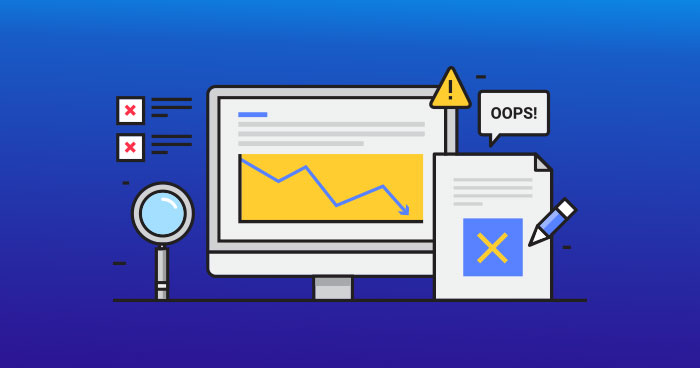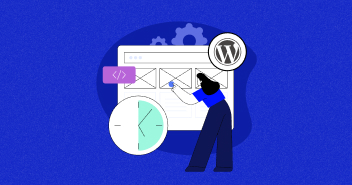
There were times when the number of keywords on a page mattered the most for search ranking. It was long ago. Search engines are constantly improving ranking algorithms. Tricks which worked at least one year ago are no more efficient.
It’s difficult enough to follow all the SEO trends as they’re changing too quickly. You may also find it challenging to strike a balance optimizing your website both for people and search engine robots. Considering these facts, it’s not surprising that even experienced marketers and business owners make some mistakes on their way.
In this post, I’ll point out the 5 most common SEO mistakes you could have made and tell about the ways of correcting them.
1. Wrong Keywords
Although most people already know that keywords quality is more important than their quantity, most of disbelieves are still associated with keywords. It’s not enough to collect all the possible key phrases. Here are some common mistakes people make using keywords:
Keywords Irrelevance
Not conducting keywords analysis is the first and the biggest SEO mistake. If your keywords aren’t relevant to the purpose of your website, don’t wait for good ranking. Using irrelevant keywords, you won’t reach your potential customers or subscribers. To target your audience, choose more precise key phrases.
For instance, if you sell building materials and another site is a blog about building houses, your aims, as well as keywords, will be different. Having a commercial website, you’ll use such phrases as ‘building materials online shop,’ ‘price list of cement,’ ‘order building materials online,’ etc. For an informational site on the same subject, your key phrases will be ‘build house,’ ‘how to build a house,’ ‘can I build a house,’ etc.
Now, try to remove topical words from these phrases. ‘Online shop,’ ‘price list,’ and ‘order online’ will be left for a commercial site, and ‘how to,’ and ‘can I’ for informational one. These are the phrases you should use with your topical keywords.
Not Tracking Trending Keywords
Never create content at random topics. If you want to write a new post, check whether its subject is popular enough. You can use Google Trends for this purpose. Enter the word describing the topic best of all into its search field:

Search volume for some keywords may change depending on a season or a country you create your content for. Don’t be surprised if people don’t search for woolen sweaters in Sri Lanka. Trending keywords analysis may not only help you increase your visibility but also check, whether a product, service or information you provide is in demand.
High Keyword Difficulty Level
This factor is crucial for those who have just entered the niche. Most people think that the higher a keyword search volume is, the more chances to get a high traffic they have. Remember that this rule doesn’t work if you are a new player on the market.
If a word is popular enough, then some big brands have already written on this topic. So, you’ll have to take huge efforts to hit the top with your site. At the beginning of your way, you’ve got much more other things to worry about. Start selecting keywords with low or middle keyword difficulty level. You should consider this parameter not to keep struggling for high ranking for years.
Of course, you won’t estimate it by yourself. There are several SEO tools, such as Serpstat and Moz, which evaluate this data for you.

Mind that numbers higher than 50 mean it’ll be pretty tough for you to compete.
Keywords Stuffing
Using your target keywords in every sentence isn’t the best idea. It doesn’t only provide poor users’ experience but also brings no profit to your ranking. This simple mistake may ruin your SEO strategy.
Keywords stuffing makes your content look unnatural and spammy. Let’s see what Google considers ‘stuffing’:

2. Irrelevant Title tags and Meta descriptions
First of all, title tags and meta descriptions are bits of HTML code considered by search engines while crawling your website. These elements provide information on the content of your page and can help you improve your ranking easily. Here’s how it looks in a code:
<title>SEO Trends: What You Need to Know for 2018</title>
<meta name=“description” content=“SEO is constantly changing, and we are all working hard to keep up. To give you an edge, here are the key SEO trends that are sure to be important for 2018.” />
Secondly, the data given in title tags and meta descriptions form the snippet shown in the SERP. It influences users’ decision on whether to visit your page or not. Here’s the way people see it:

Not using relevant meta title and description may also cause deterioration of behavioral factors. What does it mean? Let’s imagine you search for ‘iphone xs’ willing to find out its features and news about it. Search engines show you results both informational and commercial:


You’ll open only those pages which have informational intent, as you’re not going to buy anything. If some website selling smartphones doesn’t mark its commercial intent in its snippet, you may visit it and fail to find the necessary information. In this case, time you spent on a website will be very short. Search engine robot will notice it crawling the website and decide that the page isn’t relevant to the search question. In this case, the page will lose its position in search results.
Are You On The Right Way?
To make sure you didn’t make any SEO mistakes conducting keywords analysis for the title, h1 and the text of your page, you can check it with Serpstat Text Analytics. To do it, start with Keyword Clustering: create a project and attach URL of the page you want to analyze > add all the keywords you use on your page > select a search engine and region > chose a type of clustering > click on Finish. When the result is ready, open the project and click on Start text analysis. Its results provide you with automated suggestions for optimizing meta tags and text of the page:

3. Technical Optimization
Are you sure search spiders crawl your site and index your content properly? If you don’t conduct a technical SEO audit, you have no foundation for good ranking. I’ll go with the factors website owners fail to consider most often.
Low Website Speed
In the long process of collecting keywords and improving your content, you could simply overlook such a crucial factor as page speed. This SEO mistake can lead to several consequences.
First and foremost, a time your users should wait for your web page to get loaded depends on your page speed. If people wait for too long, they’ll return to search results before they even see your page.
Secondly, Google announced that it considers page speed ranking factor since 2010. Experienced website owners have already been taking advantage of this data for eight years. Of course, it’s never too late to start.
Check Out Tips To Improve Website Speed
It’s essential to check this parameter every time you add extra information, such as images, videos, and documents to your page. You can test your website’s user experience with our Page Experience Checker tool or use Google’s PageSpeed Insight to analyze your website speed.

Ignoring Site Architecture
The number and quality of pages search spiders crawl in one session depends on your site structure. If you don’t optimize it, how should search robots find the most important and quality content?
Here are a few factors you should consider organizing your site architecture:
- File robots.txt. Crawling your site, search robots will go everywhere they’re allowed. You can control this process. Create this file to block search engines from indexing pages you don’t want your site to be ranked for.
- Sitemap. This file helps you provide a clear structure of your website for crawlers to highlight your site’s key elements.
- Group your content logically.
- URL structure. With URL you can represent your logically grouped hierarchy of pages for search engines to understand your site’s structure better.
- Internal links. These links are important when you want to improve the visibility of your older posts topically related to your new ones. Link to the pages within one category. It’ll let your users flow between different resources on your site.
Not Optimized Visuals
Not optimizing your visuals you lose great opportunities of improving your ranking. First of all, limit their size, not to lower your page speed. It’s very convenient to use jpg format for photos and png for graphics.
One more thing you should consider is Alt-image text. Add it to help search engines understand what is depicted on your images. Due to this action, your pictures will be ranked in relevant search results.
Duplicate Content
You may have failed to notice, but it’s very possible that your website contains duplicate content. What is it? It’s the same content which exists on more than one page of your website. When facing such a content search engines can’t decide which pages they should index. As a result, this content won’t be shown in search results.
To identify these pages, you can use Siteliner. Enter your domain in the search field and get ready to find out whether your site contains duplicate content.

To avoid possible problems associated with the duplicate content, delete these pages. If you can’t remove them for some reasons, you can:
- use 301 redirect to the pages with original content;
- place ‘rel canonical’ tag on your original page.
One of these actions will help you identify the prioritized page version for search engines to index it.
Not Being Mobile-Friendly
Although the number of people using mobile devices for search is increasing day to day, by no means all website owners created mobile versions of their sites.
People use their smartphones almost every time they want to search for some goods or information. It’s quite complicated to view a desktop version of a site on a mobile device. Not to lose most of your potential visitors, make your website mobile-friendly as soon as possible.
What’s the most important, from July 2018 Google considers mobile page speed when ranking websites for the mobile search results. So, make sure that optimizing mobile page speed is the second thing you do after optimizing your desktop version.
To test your site’s ‘mobile-friendliness,’ run Mobile-Friendly Test.

4. Low-Quality Content
Copied content isn’t only easily identified but also penalized by search engines. To improve your site ranking and engage new visitors, create unique and high-quality content.
Always remember that you run your website for people, not for search robots. To make users stay on your page once they’ve come to it, follow these tips:
- Structurize the content.
- Use visuals.
- Mind your spelling.
- Create content relevant to keywords you’ve selected.
- Stay unique.
Outdated content also doesn’t do any good to your business. If you aren’t aware of the current tendencies and audience’s interests, you won’t create content your customers are looking for. Fortunately, there are various SEO tools, such as AnswerThePublic and Serpstat, which cope with it. Enter a keyword which is related to your subject and discover all the popular search questions. These questions will provide you with new ideas for your content.

5. Ignoring Competitive Analysis
Some people neglect this stage of site optimization. Not conducting competitive analysis you miss a chance to avoid mistakes other market players have made. Analyzing your rivals, you can also find something new to implement to your strategy.
First of all, identify who your competitors are. The market is constantly growing, so your today’s rivals aren’t the same which were yesterday. Go with Serpstat, Ahrefs, or SEMrush to track your competitors.

Using these tools, you can analyze such an important data as:
- Keywords they use.
- Sites they get backlinks from.
- Examples of their meta tags.
- Site structure they create.
- Their main traffic sources.
Mind that you should never copy your competitors. The information you found out should help you come up with ideas of improving your marketing strategy.
Not Evaluating Results
The last but not the least… Once you’ve corrected all the mistakes and developed your SEO, you should never forget to evaluate your results. Trends are constantly changing, so always keep reviewing your analytics and optimizing your website. Also, mind that some technical mistakes may occur over time.
Never stop investigating ways of making your strategy more and more efficient. Wish you good luck on your way of internet marketing!
Disclaimer: This is a guest post by Inna Yatsyna, Content Marketing Specialist at Serpstat. The opinions and ideas expressed herein are author’s own, and in no way reflect Cloudways position.
Jamil Ali Ahmed
Jamil is an Organic Search Manager at Cloudways - A SEO friendly hosting Platform. He has 14 years experience in SEO, and is passionate about Digital Marketing and Growth Optimization. Jamil is a Minimalist, Observer, Loves Nature, Animals, Food, Cricket & Mimicking :)

